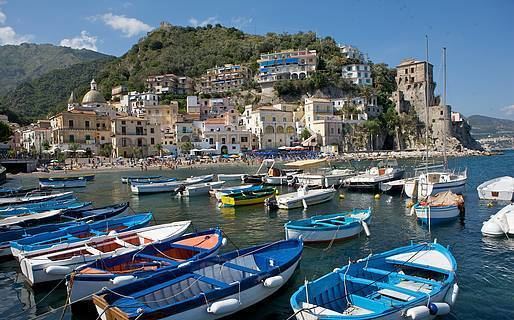Elevation 80 m (260 ft) Local time Monday 8:24 AM | ||
 | ||
Demonym(s) Vietresi (Dialect: Vietraiuli) Weather 14°C, Wind E at 11 km/h, 72% Humidity Points of interest Sorrento Peninsula, Villa Guariglia, Museo della Ceramica, Torre D'Albori | ||
Vietri sul mare italy italia
Vietri sul Mare ("Vietri on the Sea") is a town and comune in the province of Salerno, in the Campania region of southern Italy. It is situated just west of Salerno, separated from the Port of Salerno by only a harbour wall. The town is known for its polychrome ceramics, a tradition since at least the 15th century, and is considered to be the gateway to the Amalfi Coast.
Contents
- Vietri sul mare italy italia
- Map of Vietri sul Mare Province of Salerno Italy
- Geography
- Landmarks
- Notable people
- References
Map of Vietri sul Mare, Province of Salerno, Italy
The main landmark is the Church of St. John the Baptist, a late Neapolitan Renaissance style building with a high bell tower. There are numerous buildings displaying ceramics, including the Museo Provinciale della Ceramica in the nearby village of Raito.
Geography
The town is bordered by Cava de' Tirreni, Cetara, Maiori and Salerno. The quarter by the sea, named Marina di Vietri is located to the south of the town. The other frazioni are Albori, Benincasa, Dragonea (including the localities of Iaconti and San Vincenzo) and Molina.
Landmarks
The principal church in Vietri sul Mare is the Church of St. John the Baptist, a late Neapolitan Renaissance style building with a high bell tower. A previous church dated from the 10th century. It contains a coffered gold ceiling, a 17th century marble altar, an albaster statue of the Saint, and an 11th century wooden crucifix. The Confraternity of the Annunciation and the Rosary dates to the 17th century and is noted for its facade decorated with pottery. Other notable churches include the 16th century Church of the Madonna delle Grazie in Raito, the Church of Santa Margherita in Albori and the Church of Santa Maria delle Grazie in Benincasa.
The Palazzo Solimene was built after World War II by Paolo Soleri, and houses ceramic collections. The Palazzo Taiani is noted for its dovecote tower, which was once used to watch out for Saracens during raids. The nearby village of Raito contains the Museo Provinciale della Ceramica.
